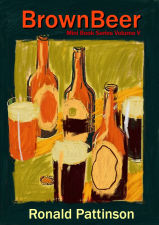I rise just after 9 AM and have a shower. Now I feel better.
Today will be an odd day. After checking out of our hotel, we have around 10 hours to kill before going to the airport. Our flight is at 00:40. What could we possibly do? Hang around in pubs, I guess.
We check out at 11 AM and dump our bags.
Lion Brewery opens at noon and isn’t far away. That’ll do. The walk there takes us through Chinatown.
It’s warm. Very warm. By the time we get to the Buddha Tooth temple, we’re in need of a cold drink. And pop into the little hawker centre we ate in yesterday. We each get a cola and take seats. Directly underneath a giant fan.
After a little cooling, we carry on to Lion Brewery. Plonk ourselves down and spend a few moments appreciating the airco. Then order some beers. Nitro Stout for me, Pilsner for Amdrew.
It’s pretty quiet. Though they have just opened. It’s all very low-key. Which is how I generally like things. Dead, I think, is the technical term.
The Stout is OK. But quite burnt tasting. I explain to Andrew that there’s a long history of Stout brewing around this way. He continues to play with his phone. That’s how impressed he is.
I’m not drinking very quickly. We’re going to be here for a long time. I don’t want to get too pissed. Or spend too much money.
There’s tennis on the TV.
“You’re not keen on tennis, are you, Dad?”
“No.”
“Boring as fuck. Isn’t that what you said?”
“Something like that. Though I may have been less subtle.”
Feeling peckish after a while, I order baked oysters. Very tasty, they are.
“That’s not much of a meal, Dad.”
“You can talk. You’ve only had about three full meals all trip. And that’s counting the bacon and beans breakfast.”
“I’m having a cheeseburger.”
“And it’s just my starter.”
I’ve switched to Boss IPA. It’s alright. Doesn’t blow my socks off, but it’s perfectly drinkable.
The tennis seems to be on a loop. The same handful of games, over and over.
“This is a preview of hell, Andrew.”
“What?”
“Endless repeats of boring tennis matches. For all eternity.”
“We’ll only be here until seven.”
“That’ll seem like an eternity.”
“Exaggerating, as always.”
Totally out of character, Andrew shows an interest in food. For a full meal, at that.
“I’m having a cheeseburger.”
“Oh, you’re being serious. I’d assumed that was a joke. Given your record, so far.”
“Very funny, Dad. You haven’t exactly been stuffing yourself.”
”OK. Jalapeno bacon mac and cheese for me. It really should be macaroni cheese. That’s the proper name for it.”
“Back when all the computers were still clockwork.”
“Ha, fucking, ha.” I’m always there with a witty riposte.
“And that’s only a small meal, according to the menu. Whatever you want to call it.”
“Fuck off, smartarse.” Wit just comes naturally to me.
We do some more bonding as the clock moves slowly around. And the pace of my drinking gets ever slower. Which is weird. Usually, I’d be speeding up. Am I getting old? Or just sensible?
A taxi gets us to Changi in plenty of time. Though dropping our bags takes longer than usual. Nothing too crazy.
The Qantas lounge is massive. And fairly empty. No trouble finding seats. No Cooper, but Stone & Wood and Little Creatures Pale Ale on tap. Plus some Lagery stuff.
“A whisky with one ice cube, please.”
Andrew goes for a Stone & Wood.
They’ve got beef rendang. The proper consistency, not the soup they had in the Schiphol lounge. Just mot spicy enough. Which is surprising.
We’ve got a few hours. No rush. I whip out my laptop and watch some rubbish.
It’s a good job they only serve stingy single measures of spirits. Saved me from getting too pissed. Not a good idea before a long flight.
Our gate isn’t too far from the lounge. By the standards of Changi. It’s just big. The last gates on pier C are almost in Malaysia.
A full flight again. Which is always fun. Chicken or pasta are the food options. Not sure if I’ve had this chicken curry and rice before. Better than some of their meals. At least there’s a bit of heat to it.
I watch The Accountant II over my gourmet dinner. Filling the time until lights out. When it’s lights out for me, too.
Six hours of blissful sleep. Followed by some dozing. When I get bored of that, I turn to Black Bag. Made me think of the Viz cartoon. Where there’s a black plastic bin bag blowing around the moors like a sheepdog. Not a bad film. And it finishes just before landing.
Breakfast is weird. There’s this weird sliced up dumpling thing. What the fuck is it? There’s some fruit, too. I eat Andrew’s, as well as mine.
At passport control, a lady ushers some passengers to the electronic gates.
“Nedelandse passen. [Dutch passports].”
Happens every time.
Our bags take a while to unload. The carousel is full. No-one is taking a bag off. Leaving no room for new ones. Eventually, there’s a space for our bags.
The taxi winds his way into Amsterdam. This is the morning rush hour. But, it being the holidays, the traffic is fine.
Soon, we’re greeted by Dolores and cups of tea. It’s good to be home. And in one piece. At least, as far as I can tell.





















































































































